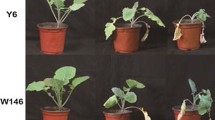Abstract
Alloplasmic lines of Brassica carinata were developed from the interspecific crosses B. napus × B. carinata and B. juncea × B. carinata followed by repeated backcrossing to B. carinata as the recurrent male parent up to the BC7 generation. The BC7 generations with cytoplasm of B. napus and B. juncea were designated NC-7 and JC-7, respectively, and the corresponding euplasmic lines were designated CN-7 and CJ-7, respectively. Four lines (NC-7 vs. CN-7 and JC-7 vs. CJ-7) were grown in a closed vinyl greenhouse at 55 °C and outdoors during winter in two cold regions of China (−3 to −10 °C) to investigate the heat and cold tolerance of the alloplasmic and euplasmic lines. Plants with the cytoplasm of B. napus showed lower leaf chlorophyll content and little difference in heat tolerance, whereas plants with the cytoplasm of B. juncea showed higher severity of heat injury compared with that of the euplasmic lines with cytoplasm of B. carinata. Alloplasmic plants with cytoplasm of B. napus and B. juncea showed decreased cold tolerance compared with that of euplasmic lines with cytoplasm of B. carinata. The difference in cold tolerance also was observed in the lethal temperature of the alloplasmic and euplasmic plants. The results suggest that tolerance of extreme temperature stress was controlled mainly by the nucleus but also was affected by the cytoplasm. Interaction between the maternal genome and nucleus was also observed.




Similar content being viewed by others
References
Arumugam N, Mukhopadhyay A, Gupta V, Sodhi YS, Verma JK, Pental D, Pradhan AK (2002) Synthesis of somatic hybrids (RCBB) by fusing heat-tolerant Raphanus sativus (RR) and Brassica oleracea (CC) with Brassica nigra (BB). Plant Breed 121:168–170 (short communication)
Banga SS, Labana KS, Medhi BN (1984) Alternaria incidence in some alloplasmic lines of Indian mustard (Brassica juncea (L.) Coss.). Theor Appl Genet 67:195–196
Banga SS, Deol JS, Banga SK (2003) Alloplasmic male-sterile Brassica juncea with Enarthrocarpus lyratus cytoplasm and the introgression of gene(s) for fertility restoration from cytoplasm donor species. Theor Appl Genet 106:1390–1395
Bentolila S, Alfonso AA, Hanson MR (2002) A pentatricopeptide repeat-containing gene restores fertility to cytoplasmic male-sterile plants. Proc Natl Acad Sci USA 99:10887–10892
Beversdorf WD, Weiss-Lerman J, Erickson LR, Souza-Machada V (1980) Transfer of cytoplasmically-inherited triazine resistance from bird’s rape to cultivated oilseed rape (Brassica campestris and B. napus). Can J Genet Cytol 22:167–172
Bilger HW, Schreiber U, Lange OL (1984) Determination of leaf heat resistance: comparative investigation of chlorophyll fluorescence changes and tissue necrosis methods. Oecologia 63:256–262
Chang CT, Uesugi R, Hondo K, Kakihara F, Kato M (2007) The effect of the cytoplasms of Brassica napus and B. juncea on some characteristics of B. carinata, including flower morphology. Euphytica 158:261–270
Chang C, Kakihara F, Hondo K, Kato M (2009) Alloplasmic effects of Brassica napus and B. juncea on seed characteristics of B. carinata. Euphytica 170:317–325
Del Río M, De-Haro A, Fernández-Martínez JM (2003) Transgressive segregation of erucic acid content in Brassica carinata A. Braun. Theor Appl Genet 107:643–651
Deol JS, Shivanna KR, Prakash S, Banga SS, Robbelen G (2003) Enarthrocarpus lyratus-based cytoplasmic male sterility and fertility restorer system in Brassica rapa. Plant Breed 122:438–440
Hinata K, Konno N (1979) Studies on a male sterile strain having the Brassica campestris nucleus and the Diplotaxis muralis cytoplasm. I On the breeding procedure and some characteristics of the male sterile strain. Jpn J Breed 29:305–311
Kempken F, Pring R (1999) Plant breeding: male sterility in higher plants-fundamentals and applications. Prog Bot 60:139–166
Kitao M, Lei TT, Koike T, Tobita H, Maruyama Y, Matsumoto Y, Ang LH (2000) Temperature response and photoinhibition investigated by chlorophyll fluorescence measurements for four distinct species of dipterocarp trees. Physiol Plant 109:284–290
Knight CA, Ackerly DD (2002) An ecological and evolutionary analysis of photosynthetic thermotolerance using the temperature-dependent increase in fluorescence. Oecologia 130:505–514
Liu J-H, Landgren M, Glimelius K (1996) Transfer of the Brassica tournefortii cytoplasm to B. napus for the production of cytoplasmic male sterile B. napus. Physiol Plant 96:123–129
Pradhan AK, Mukhopadhyay A, Pental D (1991) Identification of the putative cytoplasmic donor of a CMS system in Brassica juncea. Plant Breed 106:204–208
Prakash S, Ahuja I, Upreti HC, Dinesh Kumar V, Bhat SR, Kirti PB, Chopra VL (2001) Expression of male sterility in alloplasmic Brassica juncea with Erucastrum canariense cytoplasm and the development of a fertility restoration system. Plant Breed 120:479–482
Schreiber U, Berry JA (1977) Heat-induced changes of chlorophyll fluorescence in intact leaves correlated with damage of the photosynthetic apparatus. Planta 136:233–238
Schwarz AG, Redmann RE (1989) Photosynthetic properties of C4 grass (Spartina gracilis Trin.) from northern environment. Photosynthetica 23:449–459
Smillie RM, Nott R (1979) Heat injury in leaves of alpine, temperate and tropical plants. Aust J Plant Physiol 6:135–141
Weng JH, Ueng RG (1997) Effect of temperature on photosynthesis of Miscanthus clones collected from different elevations. Photosynthetica 34:307–311
Wu Y, Zhang C, Liu C, Ren S, Zhang Y (1998) Breeding technology of alloplasmic wheat. Sci China Ser C 41:449–458
Yamada M, Hidaka T, Fukamachi H (1996) Heat tolerance in leaves of tropical fruit crops as measured by chlorophyll fluorescence. Sci Hortic 67:39–48
Acknowledgments
We express our sincere gratitude to Prof. Dr. Masahiro Kato, Laboratory of Plant Breeding, Faculty of Agriculture, Ehime University, Japan, for providing pertinent criticism from the beginning of this research to submission of the manuscript. We also thank the Tianjin Kernel Agricultural Science & Technology Co., Ltd for support.
Author information
Authors and Affiliations
Corresponding authors
Rights and permissions
About this article
Cite this article
Chang, C., Sun, D., Kakihara, F. et al. Cytoplasmic effects of Brassica napus and B. juncea on extreme temperature stresses of B. carinata . Euphytica 204, 335–342 (2015). https://doi.org/10.1007/s10681-014-1337-4
Received:
Accepted:
Published:
Issue Date:
DOI: https://doi.org/10.1007/s10681-014-1337-4




